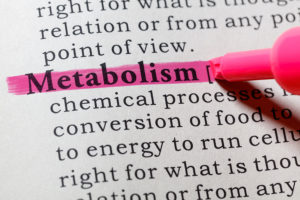Just recently I had a good client of mine ask me the question what is metabolism. And the simple  answer I gave him is your body’s ability to process your food and drink for energy. But the real answer to the question what is metabolism is a bit more complex than that.
answer I gave him is your body’s ability to process your food and drink for energy. But the real answer to the question what is metabolism is a bit more complex than that.
Here’s a definition of metabolism from Christian Nordqvist,
“Metabolism refers to biochemical processes that occur within any living organism – including humans – to maintain life. These biochemical processes allow people to grow, reproduce, repair damage, and respond to their environment.”
And when you break down this definition there are two component parts.
What is Metabolism – Two Component Parts
When you consume the food you’re eating and the liquids you’re drinking your body is going to metabolism them in two component parts:
Catabolism – the breakdown of our food and liquid into smaller molecules, which also releases energy.
Anabolism – the synthesis or building of all compounds needed to sustain life, which uses energy.
Metabolic catabolism breaks down the foods and liquids you eat and drink into smaller molecules. A good example would be the protein you eat and how the enzymes of your microbiome break this protein down into amino acids. Or how the enzymes in your saliva begin the process of breaking down starches into glucose.
As your food and liquids are broken down into these smaller molecules, energy is released. This energy creates heat, which warms your body. And this energy is stored in the molecules of adenosine triphosphate or ATP. ATP is considered “the energy currency of life.”
Metobolic anabolism is the process of synthesizing or creating the building blocks necessary for sustaining life. As the smaller molecules (that are created in catabolism) are absorbed into your bloodstream, they are then transported to various tissues and organ systems in your body.
Then through an enzymatic process these tissues and organ systems create the needed building blocks for tissue repair, function, growth, and development. For example your pituitary gland creates the hormones needed for growth. Or how your pancreas synthesizes the hormone insulin, which helps regulate your blood glucose levels.
And energy is required to create these building blocks of life. This energy comes from ATP – “the energy currency of life.”
The more efficient your metabolism, the more effective your body is in creating the building blocks of life and then reassembling them into the structures needed to maintain life. The energy released in the process is stored, so that the energy needed to build can be used at the appropriate time.
What is Metabolism – Carbohydrates, Fats, Protein, Vitamins and Minerals
Just as there are two components to metabolism there are also components nutrients needed to make this work.
Carbohydrates come in three forms: starch, sugar, and cellulose or fiber. Starches and sugars are used to form the essential source of energy used by humans. That being glucose. When glucose is metabolized it yields CO2 (carbon dioxide), H2O (water), and energy. Energy to form ATP. Water to hydrate your body. Carbon dioxide, which when breathed out, can be used by plants to sustain their life through plant metabolism.
And while the cellulose or fiber becomes bulk for your stools, it also becomes the needed fuel for your gut microbiome to supply their needed energy to fuel their enzymatic processes. This allows you to properly break down your food.
Proteins are the main tissue builders for the body. Proteins help in cell structure and function, create the needed enzymes to carry out the chemical reactions, and supply the needed nitrogen for your genetic DNA and RNA.
Plus when proteins are broken down to amino acids, the energy released is stored as ATP to help provide the needed energy in the reassembling process.
Fats are concentrated sources of energy since they provide, on average, twice as much energy as either carbohydrates or proteins. Fats are broken down into essential fatty acids, which when reassembled help to form cellular membranes, insulation and protection around vital organs, ability to transport fat soluble vitamins, and provide a reserve storage for energy.
Minerals and vitamins do not directly produce energy but help provide the components for all metabolic reactions. This includes the proper breakdown of food, the ability to properly store energy, and the ability to synthesize or reform the essential organic compounds that keep you alive.
With over 500 different metabolic pathways used by the human body, the need for minerals and vitamins are an important component for these enzymatic processes to work properly.
This post is just a small insight in the question what is metabolism. Again, in its simplest terms metabolism is the breakdown of the foods and liquids we consume into energy and the needed building blocks necessary to reform them into structures and functions needed to maintain life. Simple in concept but extremely complex and precise in actual operation.
Especially when you factor in your microbiome and its metabolism to help you maintain your metabolism.
Leave a Reply
You must be logged in to post a comment.